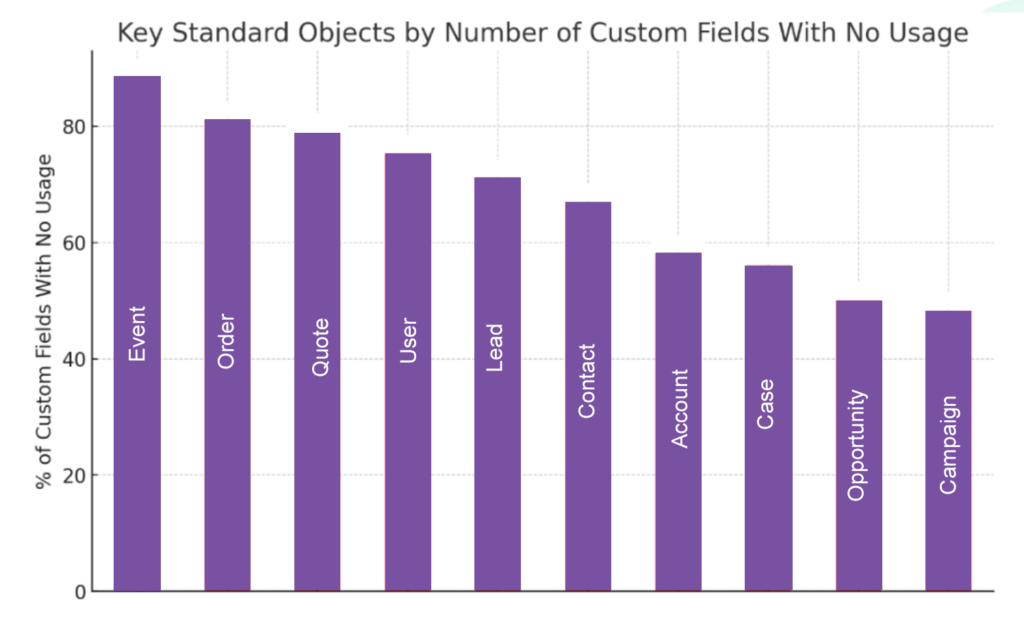
The Change Intelligence Research Series: Reinforcing best practices in Salesforce
What is the Change Intelligence Research Series?
The aim of the Change Intelligence Research Series is to highlight the state of Salesforce customizations and highlight best practices. We analyze the metadata from a number of different perspectives looking at common use cases. We then invite experts to provide their perspectives and highlight the best practices, that need to be applied.
Where does the data come from?
We sync 50,000 Orgs per month and last month we analyzed 1.3 BILLION metadata items. So much research is based on user-submitted survey data, which is subjective and often limited. Our research is based on real data, that is anonymized, so it is quantitative, not qualitative. We also have so much data, that any outliers do not skew the results, which can be a concern with small datasets.
As we are running analysis against the real-time data and storing our search queries, we can re-run the queries periodically to identify trends. We are using GPT to run the queries and produce the graphics which has dramatically reduced the effort to produce the results. And as the queries are analyses of real data, we are not experiencing bias or hallucinations.
Why is this important?
The insights are valuable because they are from data aggregated across so many Salesforce implementations. It enables any team to benchmark their own implementation, against the results we are reporting, and also compare them to best practices.
The aim of the research is to give teams the information they need to build a business case to take action. Our experience is that Salesforce implementation teams – internal or consultants – are driven by the business to create more functionality, more quickly. This impacts their ability to spend time on activities that can have a long-term impact on the health of the implementation and the ability to stay agile: business analysis, architecture, tech debt, and documentation.
Our hope is the research enables teams to demonstrate what is required to build and maintain healthier implementations. And therefore they are able to prioritize the work that does not appear to be taking the business forward in the short term but will futureproof the implementation.
Current and future topics
#1 User Experience
7- the perfect number
The first report in the series looked at User Experience. The fascinating insight came from Stephy Hogan, Director of User Experience at Red Argyle. It was the number 7. That is the number of fields that should be on a screen to maximize the User Experience. More than that and there is a cognitive overload. The sad news is that on average the Opportunity object has 150 fields. And whilst that is the highest of all the standard objects, they all average over 50. Even the humble case object.

For custom objects, where every field has been created based on some user need, the average number of fields on a page is 26.8. So lower than standard objects and the overall average, but still nearly 4 times the optimum.

Dynamic forms offer a solution
Dynamic forms can be used to simplify page layouts by hiding fields based on the data in other fields or the value of a record type. So an example would be displaying fields on opportunity based on stage field. However dynamic forms are not widely used.
Only 17.3% of record Lightning pages use any form of conditional logic. 10.2% of all record Lightning pages use fields for filtering logic, and 8.9% use non-field filters (picklist values, record types, roles, or profiles).

Taking action
Salesforce has provided the capabilities to provide a far better User Experience, but there is a clear education or implementation gap. It starts with understanding the different journeys or needs by role. This can be documented as a UPN process diagram. Then you can understand how to tailor screens using dynamic forms.

Salesforce is immensely powerful and is improving constantly. As I tell all of my design friends… it’s not the tool. It’s the tool behind the tool. You don’t blame the hammer if you build a chair with 2 legs.
Alongside this perfect summary, Stephy Hogan offers even more insight into improving Salesforce UX, in the full report, Untapped Opportunities in User Experience. The report, co-authored by Xavery Lisinski, is available for download today.
#2: Unrealized impact and hidden waste
50% never gets used
Every Salesforce team battles with Org complexity and technical debt on every project. But how much of the functionality that has been built – objects, fields, flows, apex – ever gets used?
We can all come up with our assessment. But we have the answer based on our research: over 50%. This is a staggering level of waste and makes us question the data. The analysis looks at custom objects and fields that were created in the last 12 months but were never populated.

And the story gets even worse when you look at custom fields that are created on standard objects that never get populated. And many of these are defaulted onto page layouts, as we saw from the first report.

The financial implications are huge:
- The effort creating the field and everything related to it – page layouts, validation rules, permissions, etc
- Every time you make a change, there is effort in doing unnecessary impact assessment on the field and associated metadata
- Wasted effort reviewing and documenting fields when preparing for Data Cloud and AI
And this data is only looking at what was created in the last year. If an Org is 5 years old, then how much technical debt has built up over time if 50% of every year’s new functionality is not used?
Taking action
The clear message is that teams need to allocate time to technical debt reduction. This can have an immediate saving. But then the action is to put in place a more rigorous business analysis process so that there is better validation of requirements. That should stop teams wasting time developing stuff that is never used – and therefore needed.
What do you need from the Research Series?
Whilst we have a number of aspects of the data that we want to explore based on the last 20+ years of being Salesforce customers. We want to provide you with the benchmark data you need as you try to change behaviors.
The Change Intelligence Research Series is growing monthly. Focussing on one data point at a time, our upcoming reports will continue to unlock the potential within Salesforce. Download the first report in our Change Intelligence Research Series, Untapped Opportunities in User Experience, today.
Sign up for
our newsletter
Subscribe to our newsletter to stay up-to-date with cutting-edge industry insights and timely product updates.

Ian Gotts
Founder & CEO6 minute read
Published: 5th April 2024






